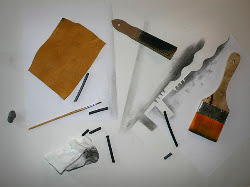
1. Loosen Up- Drawing shouldn’t be stiff, it should be “controlled” when starting out the differences can seem like double talk but it’s not. Try holding your pencil further towards the back and using your whole arm, elbow or wrist. You will be looser with your marks you have to be, also try keeping your hand off the paper. These two things will help you to “loosen Up”. Also don’t be afraid to try several times to get the line right. It can seem strange but you’ll have a better chance of finding the right line. It’s a little like winning a raffle the more tickets you have the better your chance of winning.
2. Look for Basic Shapes- I am sure everyone who has taken my drawing is rolling their eyes at this one. I know I mention it time and time again. Because it’s that important, every time I am having a problem with my drawing I always start by reassessing the basic shapes and observing the objects to see if the basic shape relationships are accurate. We are very adept at seeing shapes and everything can be simplified into basic shapes, squares, rectangles, triangles, cones, cylinders and spheres. It is effective approach and it will help you every time you simplify things into basic shapes.
3. Have Definite Areas of Light, Medium and Dark Values- Value is such a powerful tool but sometimes it is hard to create and control. Whenever you have a drawing that seems to lack any visual impact ask yourself if the drawing has a full range of values. Every drawing should have definite areas of dark values, middle values and light values. If not it will look flat. Every individual object should also have definite areas or planes of dark medium and light. By increasing the range of values your drawings will be much more powerful.
4. Ignore the Details- Too many times we are fooled or distracted by details. As a beginner it’s hard not to focus on details entirely. It’s tempting to jump in and try to render every last detail with absolute fervor. Unfortunately if you try to work this way you will end getting lost in the details and end up with a poor drawing. The reason is you missed the “big picture”. This doesn’t mean to not include details it means in the beginning look to the “Big Picture”. You do that by sticking to the basics which always starts with the shadowing of an object. For example: If I was drawing a tennis ball I would start with a sphere that was properly shaded with all the “form shadows” in place. Once I had done that I would begin to add the details. The details have to conform to the “form shadows” of the object. After you have you basic shading you can begin to hint at details instead of trying to draw every single fuzzy on the tennis ball. Working this way will give an amazingly convincing drawing.
Ignoring the details at the start of a drawing is one of the most important concepts in drawing! Take landscape drawing as an example. Even the most detailed of landscape drawings have left out tons of details. There just isn’t enough time in 6 months to add every detail to a landscape drawing. Instead artists focus on shapes and “form shadows” to describe their landscape. The same thing applies to whatever you draw. Look below at the drawing. It is very clear and has implied details but it is more about the shading than the minute details.
5: Learn to Deal with Ellipses- Ellipses, which is a circle foreshortened in perspective, are some of the hardest things for a beginner and even an experienced artist. Here are a couple of things to remember. When drawing ovals.
1. No matter how tight or pinched the oval is the ends should be rounded not pointed.
2. Use a rule or straight edge to make sure the oval is lined up corner to corner.
3. Use a line through the center of the oval to help yourself as you draw an oval.
Use these three tips to practice, practice and practice some more.

